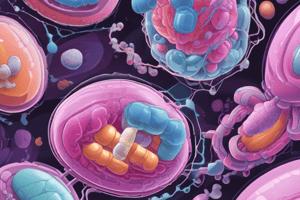Podcast
Questions and Answers
What is the most common cause of urinary tract infections by Escherichia coli?
What is the most common cause of urinary tract infections by Escherichia coli?
- Proteus mirabilis
- Klebsiella pneumoniae
- Pseudomonas aeruginosa
- Escherichia coli (correct)
What resistance mechanism is particularly noted in Escherichia coli strains that produce extended-spectrum beta-lactamases (ESBL)?
What resistance mechanism is particularly noted in Escherichia coli strains that produce extended-spectrum beta-lactamases (ESBL)?
- Hydrolysis of beta-lactam antibiotics (correct)
- Biofilm formation
- Increased efflux pumps
- Altered target sites
Which antibiotics are typically effective against carbapenem-resistant Klebsiella pneumoniae?
Which antibiotics are typically effective against carbapenem-resistant Klebsiella pneumoniae?
- Vancomycin
- Ciprofloxacin
- Amoxicillin
- Polymyxins (correct)
What clinical infections are commonly associated with Pseudomonas aeruginosa?
What clinical infections are commonly associated with Pseudomonas aeruginosa?
What is a significant characteristic of Burkholderia cepacia in cystic fibrosis patients?
What is a significant characteristic of Burkholderia cepacia in cystic fibrosis patients?
Why is Stenotrophomonas maltophilia often resistant to many antibiotics?
Why is Stenotrophomonas maltophilia often resistant to many antibiotics?
What makes Acinetobacter baumannii particularly challenging to treat?
What makes Acinetobacter baumannii particularly challenging to treat?
Which antibiotics are considered last-resort options for treating infections caused by multidrug-resistant Acinetobacter baumannii?
Which antibiotics are considered last-resort options for treating infections caused by multidrug-resistant Acinetobacter baumannii?
What is a common clinical condition caused by Klebsiella pneumoniae?
What is a common clinical condition caused by Klebsiella pneumoniae?
Which virulence factor is associated with Proteus mirabilis in urinary tract infections?
Which virulence factor is associated with Proteus mirabilis in urinary tract infections?
What is the primary resistance mechanism employed by Pseudomonas aeruginosa?
What is the primary resistance mechanism employed by Pseudomonas aeruginosa?
What challenges are associated with treating Burkholderia cepacia infections?
What challenges are associated with treating Burkholderia cepacia infections?
Which antibiotic regimen is commonly considered effective against multi-drug resistant Stenotrophomonas maltophilia?
Which antibiotic regimen is commonly considered effective against multi-drug resistant Stenotrophomonas maltophilia?
What is a common clinical sequela associated with Acinetobacter baumannii infections?
What is a common clinical sequela associated with Acinetobacter baumannii infections?
Which of the following antibiotics is often ineffective against Klebsiella pneumoniae producing carbapenemase?
Which of the following antibiotics is often ineffective against Klebsiella pneumoniae producing carbapenemase?
What unique mechanism contributes to the kidney stone formation by Proteus mirabilis?
What unique mechanism contributes to the kidney stone formation by Proteus mirabilis?
Flashcards are hidden until you start studying
Study Notes
Escherichia coli
- Common cause of urinary tract infections (UTIs)
- Typically treated with antibiotics like trimethoprim-sulfamethoxazole (TMP-SMX), nitrofurantoin, or fluoroquinolones
- Resistance Mechanisms:
- Extended-spectrum beta-lactamases (ESBLs)
- Production of AmpC β-Lactamase
Klebsiella pneumoniae
- Causes pneumonia, urinary tract infections, bacteremia, and wound infections
- Carbapenemase-producing strains are significant due to their resistance to carbapenem antibiotics, often requiring last-resort treatment options
- Carbapenem-resistant strains can be challenging to treat, and options may include polymyxins, tigecycline, or combination therapies
Proteus mirabilis
- Key virulence factors in UTIs:
- Urease production, leading to ammonia formation, which alkalinizes urine and promotes stone formation
- Flagella, responsible for motility and swarming
- Typically treated with antibiotics like TMP-SMX, fluoroquinolones, or aminoglycosides
- Can contribute to kidney stone formation by breaking down urea into ammonia, increasing urinary pH, and promoting crystal formation
Pseudomonas aeruginosa
- Causes pneumonia, bacteremia, wound infections, and other infections, especially in immunocompromised individuals
- Resistance Mechanisms:
- Efflux pumps
- Modifications of antibiotic targets
- Production of β-lactamases
- Biofilm formation
- Treatment for multidrug-resistant strains:
- Inhaled tobramycin
- Colistin
- Ceftazidime-avibactam
Burkholderia cepacia
- Significant in cystic fibrosis patients, causing respiratory infections and exacerbating lung disease
- Treatment can be challenging due to its inherent resistance to many antibiotics
- Options:
- Ceftazidime
- Meropenem
- Tobramycin
Stenotrophomonas maltophilia
- Often resistant to many antibiotics, including β-lactams and aminoglycosides
- First-line treatment:
- Trimethoprim-sulfamethoxazole (TMP-SMX)
Acinetobacter baumannii
- Causes pneumonia, bacteremia, wound infections, and meningitis
- Challenge to treat due to:
- Multidrug resistance
- Ability to form biofilms
- Last-resort options:
- Colistin
- Tigecycline
Escherichia coli
- Common cause of urinary tract infections.
- Typically treated with antibiotics like fluoroquinolones, cephalosporins, and nitrofurantoin.
- Resistance mechanisms include production of extended-spectrum beta-lactamases (ESBLs), which inactivate many beta-lactam antibiotics.
Klebsiella pneumoniae
- Causes pneumonia, urinary tract infections, bacteremia, and wound infections.
- Carbapenemase-producing K. pneumoniae is a significant threat due to its resistance to many antibiotics, including carbapenems.
- Treatment of carbapenem-resistant K. pneumoniae often requires combination therapy with antibiotics like polymyxins and tigecycline.
Proteus mirabilis
- Virulence factors include urease production, which hydrolyzes urea to ammonia leading to alkaline urine and stone formation.
- Typically treated with antibiotics like fluoroquinolones, cephalosporins, and nitrofurantoin.
- High urease production contributes to urinary tract infections and formation of struvite kidney stones.
Pseudomonas aeruginosa
- Causes pneumonia, urinary tract infections, wound infections, and bacteremia, particularly in immunocompromised individuals.
- Resistance mechanisms include biofilm formation, efflux pumps, and production of extended-spectrum beta-lactamases.
- Treatment of multidrug-resistant P. aeruginosa infections often involves combination therapy or use of drugs like colistin and ceftazidime-avibactam.
Burkholderia cepacia
- Significant opportunistic pathogen in cystic fibrosis patients, leading to chronic lung infections.
- Treatment is challenging due to its multidrug resistance and biofilm formation.
- Options often include combination therapy with antibiotics like ceftazidime, meropenem, and trimethoprim-sulfamethoxazole.
Stenotrophomonas maltophilia
- Often resistant to many antibiotics due to its intrinsic resistance mechanisms.
- First-line treatment often involves trimethoprim-sulfamethoxazole or minocycline.
Acinetobacter baumannii
- Causes pneumonia, urinary tract infections, and wound infections, often in hospitalized patients.
- Difficult to treat due to its intrinsic resistance to many antibiotics and its ability to develop resistance to antibiotics with prolonged use.
- Last-resort options for multidrug-resistant A. baumannii infections include polymyxins and tigecycline.
Studying That Suits You
Use AI to generate personalized quizzes and flashcards to suit your learning preferences.



